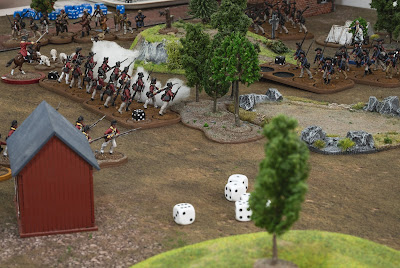As I explained in my previous post, it took me a long way to prepare what I'd call a "basic setting" for Chain of Command. Obviously one can start with a bare infantry platoon, but in my experience that does not provide a really enjoyable game. So today I'd like to share my personal view of what I discovered through trial and error.
I found official TooFatLardies Pint Sized Campaigns to be excellent starting points for any setting. They describe a more restrictive force and supports than the rule book, and they even depict different table settings so one can estimate what terrain would be required.
Game Aids
I personally hate book-keeping and note-taking. So I rather use markers on the table to
Movement trays are quite common in other games, like Sharp Practice, but tend to be rare in WW2 settings. I believe they quicken troop movement and allow a faster identification of teams.
I found Mortal Gods movement trays to be particularly useful for Chain of Command. I use the triangular 3-men hoplite ones for MG teams. And circular 3-men ones for support teams like mortars, engineers and such.
My partner rather use dice to count shock, so I've made some bases for them, so they are visually more integrated into the table and also to avoid rolling or picking them by accident. We use small black dice.
For counters I have similar solution, based white small dices that be attached to the movement trays. For example to count the 3 HE rounds in the British 2" mortar or the 3 fuel charges for flamethrowers.
Then I use "conventional" MDF or acrylic tokens for different status like: Tactical Stance, Overwatch, Broken, Pinned, -1 level for leaders.
For smoke grenades / shells I use 3" MDF bases.
Terrain
Terrain is one of the elements that in my humble opinion can make or break a game. While it's true one can use anything available like books or cans, accurate high quality terrain can give an immersion that nothing else can.
The base for me it's a good mat. I personally use the mouse pads by Deep Cut as they are resistance and their weight allows me to keep a flat surface at all times.
Entrenchments, tank barriers and wire fences. At least a minefield is also required.
Trees and hedges are really useful in most settings.
Unlike other historical settings, fencing and obstacles are vital for a modern war scenario as weapons have really long ranges and soldiers need some cover to survive.
Forces
Infantry. Infantry is the base of all force. Basically just follow whatever is explicitly stated in the Pint Sized campaign list.
Infantry supports. I believe the basic infantry supports for all forces should be a RTO/Forward observer, medic, Sniper, a flamethrower team, an engineer team and a tripod MG.
Vehicles. A couple of the most common tanks a a staple for almost all forces (except maybe Japanese). Soft / Armored Transports are not really needed in most scenarios, so I don't think they should be prioritized.
Artillery. I find that having at least an AT gun as a support is a must have for any force. Infantry guns can add some interesting options, but close fire support can also be simulated with an off-the-table medium mortar.



No comments:
Post a Comment